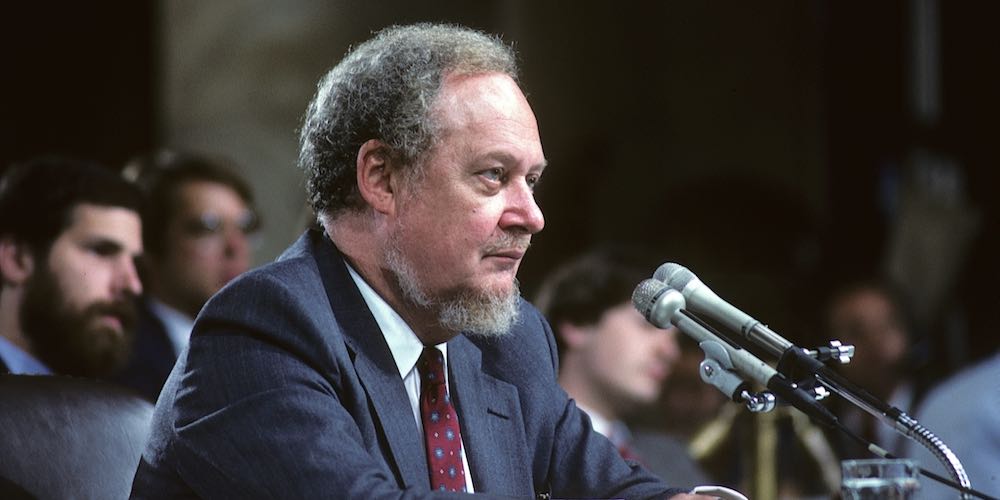Kindling a New Originalist Fire
For four decades, the conservative legal movement has been building the M1 Abrams tank of jurisprudence. Its name: originalist textualism, sometimes “the new originalism.” Its method: applying the original public meaning of legal texts to resolve controversies. Its mission: to destroy Roe v. Wade.
Origins of Originalism
To be sure, originalism was not consciously conceived to oppose Roe. Robert Bork’s early work on originalism predates Roe. He did not begin his project with answers at all. He began with questions. The Warren Court had transformed American law many times, in ways that seemed increasingly divorced from democratic accountability, from Griswold v. Connecticut to Reynolds v. Sims. Bork began looking for “neutral principles” that might bind the Court to something other than its own conceits.
Roe was an extraordinary catalyst. Even many pro-choicers agreed that Roe “is not constitutional law and gives almost no sense of an obligation to try to be.” For pro-lifers, who believed that abortion killed an innocent child, Roe‘s “anti-democratic and fundamentally anti-constitutional… judicial lawmaking” demonstrated the need for a new theory of jurisprudence, which they pursued with extreme urgency.
In originalism, pro-lifers found a lucid and concrete explanation of their instinct that the Court had exercised “legislative—as opposed to judicial—powers.” It is no embarrassment to originalism to observe that its ascent was hastened by the support of the right-to-life movement, nor is it cynical to notice that originalism’s foundation in the “original public meaning” of legal texts happens to be absolutely incompatible with the putative right to abortion established in Roe.
Decades later, the alliance of originalists and pro-lifers (among others) earned a five-vote majority on the Supreme Court, and, in 2022, that majority chose to confront Roe in the case Dobbs v. Jackson. The climactic showdown had arrived, not only for the pro-life movement, but for the finely-honed edge of originalist textualism, at last ready to do battle with its primordial antithesis.
At least, that’s what you might have expected.
The leaked draft majority opinion, by the “practical originalist” Justice Samuel Alito, would indeed be a significant victory for pro-lifers, should it become official. Yet the draft not only does not depend on originalist textualism; it bears almost no evidence of being influenced by originalism at all!
The Cloud of Substantive Due Process
Roe v. Wade and its sequel, Planned Parenthood v. Casey, located a constitutional right to abortion in the “due process” clause of the Fourteenth Amendment (or, alternatively, in the Ninth Amendment). An originalist Dobbs decision would begin with a fair but thorough evaluation of the original public meaning of the due process clause, before proceeding to the textual basis for “substantive due process” rights, their application (if any) to abortion, and the meaning and justiciability of the Ninth Amendment. This opinion would consider historical and semantic evidence regarding the Amendments’ objective meaning, according to the understanding of a reasonable person at the time of their adoption; the Amendments’ expected applications, insofar as they revealed the objective principles the Amendments embody; and finally, the application of that objective meaning to the question of abortion, using tools of constitutional interpretation or construction as appropriate. The result of this inquiry would likely foreclose not only a constitutional right to abortion, but, if Justice Thomas’s unflinching originalist case law is any indication, the entire line of substantive due process cases as well.
Fortunately for the entire line of substantive due process cases, Alito’s draft majority does nothing of the sort. Alito accepts without question the existence of substantive due process rights and their grounding in the Fourteenth Amendment. He likewise accepts the entire body of precedents that guide “discovery” of substantive due process rights. The only precedents Alito dares to doubt are Roe and Casey themselves. Those are the cases directly challenged by Mississippi in its arguments to the Court, so the opinion limits itself to those cases. The opinion does favorably cite cases from the textualist “anti-canon,” such as Griswold (albeit indirectly), but the reader will ctrl-F in vain for a single reference to “original public meaning” in Alito’s draft majority.
Having accepted substantive due process rights and the entire body of case law built on them, Justice Alito turns to the question of whether Roe (and, by extension, Casey) were correctly decided. In short, rather than analyzing them on sturdy originalist terrain, Alito chooses to confront Roe and Casey on their home turf. He grants them every advantage, every precedent they ask for, every interpretive standard they rely on—no matter how far afield it may take him from the original public meaning of the Constitution. After construing everything in their favor, Alito then asks whether Roe or Casey demonstrate a constitutional right to abortion, according to their own putative standards.
The first place Roe, Casey, and Alito look for a right to abortion is in the plain text of the Constitution. All agree that it is not there.
The second place they look is in the cloud of substantive due process jurisprudence. This cloud is not particularly well-tethered to any constitutional provision, but Alito has already stipulated to it, so the next question is: what rights are identified in substantive due process precedents?
According to these cases, “substantive due process” rights include only “principle[s] of justice so rooted in the traditions and conscience of our people as to be ranked as fundamental.” This is known as the Glucksberg Test, named for a 1997 case that ruled against assisted suicide, but the test is much older than that. That particular quotation comes from 1934’s Snyder v. Massachusetts, and the accepted formula comes from 1977’s Moore v. East Cleveland, which said that rights may be protected if they are “deeply rooted in this Nation’s history and tradition.”
Presumably to comport with these precedents, Roe v. Wade undertook a half-hearted, perfunctory historical survey of abortion rights in the United States. Justice Blackmun’s majority concluded that the nation’s history and tradition did indeed include “a substantially broader right to terminate a pregnancy than [prevails] in most States today.”
Justice Alito is unconvinced. Much of the legwork in his draft majority is devoted to a careful examination of Roe‘s research and historical claims. Although originalists will find themselves at home here, this is not an originalist analysis. This argument centers on social and cultural history. When Alito considers legal texts, it is to help reveal that history, not to analyze their original public meaning. He finds that, for most of Anglo-American history, abortion was often criminal, though sometimes (barely) tolerated, especially in the crucial period around the Fourteenth Amendment’s adoption. Positive rights to abortion cannot be considered “deeply rooted in the nation’s history and traditions,” and Roe fails the Glucksberg test.
Whatever juridic principle unites the disparate line of substantive due process cases, these precedents plainly offer no support for the absolutized autonomy on which Casey‘s abortion logic depends.
However, there is still more to be done. Roe and Casey searched high and low for a right to abortion, and Alito is determined to follow its authors through every hill and dell.
Casey discovered the right to abortion within a very broad right to “personal dignity,” including the rights to “make family decisions” and to “physical autonomy.” Casey asserts that these wide-ranging rights had been firmly established, not merely by “history and tradition,” but by precedent. However, when Alito checks the citations, he finds no such thing. Yes, as Casey notes, the Supreme Court had found that Americans have a right to contracept, to marry interracially and while incarcerated, to send their children to private school, and to refuse some highly invasive police searches. On the other hand, the Supreme Court has also found that Americans may be forcibly sterilized (sometimes), medicated (sometimes), tested for blood alcohol level, and punished for refusing a vaccine, while a state may criminalize prostitution, drug use, and child labor, even removing children from their parents in severe cases.
Whether these precedents are right or wrong, they are nevertheless the precedents Casey’s “right to physical autonomy” depends upon. Alito notes that many of these cases are quite “far afield” from the right to abortion. What, he asks, does the right to send children to German classes have to do with the right to an empty uterus? Casey is silent. Why is abortion included in this “autonomy” right, but not prostitution? Casey is silent. Whatever juridic principle unites the disparate line of substantive due process cases, these precedents plainly offer no support for the absolutized autonomy on which Casey‘s abortion logic depends. They don’t justify an abortion right any more than “history and tradition” did. Abortion finds no refuge in the jurisprudence of substantive due process.
Justice Alito gamely agrees to entertain any rational legal basis for the right to abortion, originalist or not—but he cannot accept sheer judicial wille zur macht.
In a series of cases decided after Casey, Justice Anthony Kennedy (who co-authored Casey) answered these criticisms by arguing that history, tradition, and precedent are the “starting point, but not in all cases the ending point, of the substantive due process tradition” and that they “guide and discipline this inquiry but do not set its outer boundaries.”
Alito explicitly accepts this, but presses difficult questions: What does set the outer limits of substantive due process? On what legal basis does the right to an abortion ultimately rest? Why is a 15-week abortion ban unconstitutional?
Ipse Dixit
Kennedy, Casey, and Roe offer no further legal answer. Casey here appeals to the authority of, “that same capacity which by tradition courts always have exercised: reasoned judgment.” This “judgment,” however, appears unreasoned, and includes no test, no rubric, no rule of law. Casey expressly defies “reduc[tion] to any formula” or “reference to any code” on this point. It simply is.
Clearly, the justices who decided Roe and Casey think it is good, and right, and important for American law to protect a right to abortion. As Casey says (citing no legal authority): “at the heart of liberty is the right to define one’s own concept of existence, of meaning, of the universe, and of the mystery of human life.” Many Americans passionately agree.
In Alito’s analysis, though, these justices did not execute their duty “to say what the law is.” Their idea of substantive due process is nothing more than their own beliefs about what the law ought to be.
At the heart of Roe and Casey lie the ancient maxim, “ipse dixit.” The Court itself said so.
There, Alito draws the line. “The scheme Roe produced looked like legislation, and the Court provided the sort of explanation that might be expected from a legislative body.” But the Supreme Court exists to interpret law, not to create it. “[W]e must guard against the natural human tendency to confuse what [the Fourteenth] Amendment protects with our own ardent views about the liberty that Americans should enjoy… to usurp authority that the Constitution entrusts to the people’s elected representatives.” So Alito concludes: “Both sides make important policy arguments, but supporters of Roe and Casey must show that this Court has the authority to weigh those arguments and decide how abortion may be regulated in the States. They have failed to make that showing.”
Roe and Casey fall, but not because they failed to meet the exacting standard of originalist textualism. They fall because they failed to meet the relaxed standards of substantive due process law, to which they themselves claimed to adhere. Justice Alito gamely agrees to entertain any rational legal basis for the right to abortion, originalist or not—but he cannot accept sheer judicial wille zur macht.
This is not an originalist opinion. Nevertheless, the originalist feels her heart stirring when Alito rejects the Court’s asservations.
After all, originalism did not begin with answers. It began when Robert Bork faced the Warren Court’s “Because!” and asked: “But why?” Why these rulings and not others? What neutral, objective principle connects the Ninth Amendment to contraception? Why, finally, listen to the Courts at all, and not “some other group, say the Joint Chiefs of Staff, a body with rather better means for implementing its decisions”? The entire originalist-textualist project sprang from the search for an answer to these questions, for a bulwark against an earlier Supreme Court’s ipse dixit. Justice Alito’s draft majority opinion in Dobbs v. Jackson is not part of that tradition, but it springs from the same shoot, and kindles the same fire.


